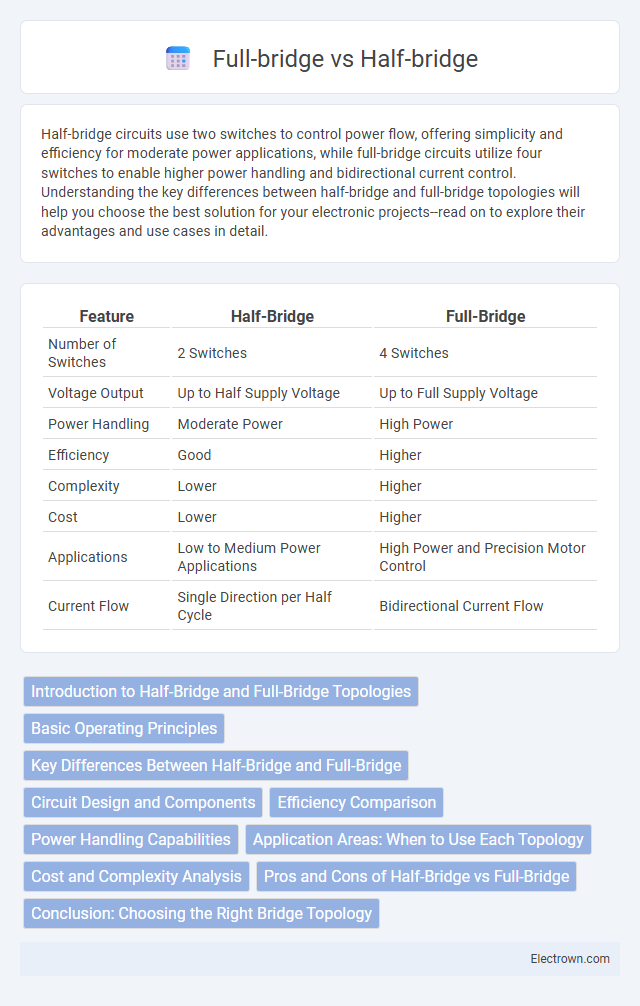Half-bridge circuits use two switches to control power flow, offering simplicity and efficiency for moderate power applications, while full-bridge circuits utilize four switches to enable higher power handling and bidirectional current control. Understanding the key differences between half-bridge and full-bridge topologies will help you choose the best solution for your electronic projects--read on to explore their advantages and use cases in detail.
Table of Comparison
| Feature | Half-Bridge | Full-Bridge |
|---|---|---|
| Number of Switches | 2 Switches | 4 Switches |
| Voltage Output | Up to Half Supply Voltage | Up to Full Supply Voltage |
| Power Handling | Moderate Power | High Power |
| Efficiency | Good | Higher |
| Complexity | Lower | Higher |
| Cost | Lower | Higher |
| Applications | Low to Medium Power Applications | High Power and Precision Motor Control |
| Current Flow | Single Direction per Half Cycle | Bidirectional Current Flow |
Introduction to Half-Bridge and Full-Bridge Topologies
Half-bridge and full-bridge topologies are fundamental configurations in power electronics used for voltage conversion and motor control. A half-bridge consists of two switches and two capacitors, enabling efficient DC-AC conversion with a simpler design suitable for medium power applications. In contrast, a full-bridge uses four switches arranged in an H-bridge formation, providing bidirectional current flow and higher power capability essential for advanced motor drives and inverter systems.
Basic Operating Principles
Half-bridge converters utilize two switches and two capacitors to divide the input voltage, enabling efficient power conversion by alternately switching each transistor and creating a variable output voltage. Full-bridge converters use four switches arranged in an H-bridge configuration, allowing for higher power output and improved efficiency by fully utilizing the input voltage across the load. Understanding these basic operating principles helps you select the appropriate topology for your power electronics application.
Key Differences Between Half-Bridge and Full-Bridge
Half-bridge and full-bridge circuits differ primarily in their configuration and power handling capabilities, where a half-bridge uses two switches to control the load, while a full-bridge employs four switches for greater control and power delivery. Full-bridge circuits offer improved efficiency and the ability to drive loads in both directions, making them suitable for applications requiring bidirectional current flow, unlike half-bridges which typically support unidirectional operation. Understanding these distinctions helps you choose the right bridge topology based on your system's voltage, current requirements, and control complexity.
Circuit Design and Components
Half-bridge circuits utilize two switching components and typically include two capacitors forming a voltage divider, allowing for simpler design and reduced component count. Full-bridge circuits employ four switching elements arranged in an H-bridge configuration, enabling bidirectional current flow and improved power handling. The full-bridge design requires more complex control but offers higher efficiency and better performance in applications demanding greater power output or motor direction control.
Efficiency Comparison
Half-bridge converters typically offer higher efficiency in low to medium power applications due to reduced switching losses and simpler design. Full-bridge converters provide better efficiency at higher power levels by effectively handling greater power loads and minimizing voltage stress on components. Efficiency in both topologies depends on factors like load conditions, switching frequency, and component quality, with full-bridge often favored for demanding, high-power environments.
Power Handling Capabilities
Half-bridge converters typically handle moderate power levels efficiently, making them suitable for applications requiring medium power with lower component counts. Full-bridge converters excel in high-power scenarios by providing better voltage utilization and symmetrical current distribution, which reduces stress on components and improves heat dissipation. The choice between half-bridge and full-bridge designs directly impacts power handling capabilities, efficiency, and thermal management in power electronics.
Application Areas: When to Use Each Topology
Half-bridge topologies are ideal for low to medium power applications such as motor drives, DC-DC converters, and battery management systems where cost and efficiency are critical. Full-bridge configurations excel in high-power applications including industrial motor control, renewable energy inverters, and uninterruptible power supplies due to their ability to deliver higher voltage and power output. Your choice depends on the required power level, complexity, and efficiency demands of your specific application.
Cost and Complexity Analysis
Half-bridge converters generally offer lower cost and reduced circuit complexity compared to full-bridge configurations due to fewer semiconductor components and simpler control requirements. Full-bridge converters, while more expensive and complex, provide improved power handling, higher output voltage capabilities, and better efficiency in high-power applications. The trade-off between cost and complexity versus performance must be evaluated based on the specific power rating and operational needs of the application.
Pros and Cons of Half-Bridge vs Full-Bridge
Half-bridge configurations offer lower component count and reduced cost, making them suitable for applications with moderate power requirements and simpler control needs, but they typically provide less power output and efficiency compared to full-bridge designs. Full-bridge topologies deliver higher power handling, improved efficiency, and better control over load direction, which is essential for demanding applications but come with increased complexity, higher component count, and greater cost. Your choice between half-bridge and full-bridge should balance power demands, efficiency goals, and budget constraints to optimize performance and reliability.
Conclusion: Choosing the Right Bridge Topology
Selecting the appropriate bridge topology depends on your application's power requirements and complexity. Half-bridge circuits offer simpler design and lower component count, making them suitable for moderate power applications with cost constraints. Full-bridge configurations provide higher efficiency and better control over power delivery, ideal for high-performance electric motor drives and advanced inverter systems.
Half-bridge vs Full-bridge Infographic

 electrown.com
electrown.com